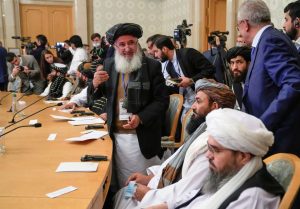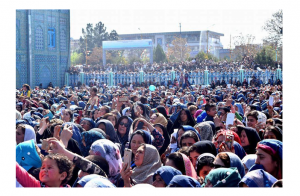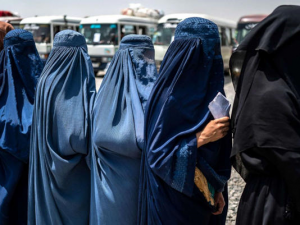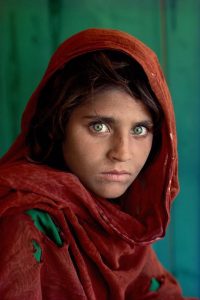Women in Afghanistan make up a little less than half of the country’s population. According to the latest World Bank Development Indicators (2020), with over 19 million soles, 48.72 percent of the country’s 39 million citizens consist of women and girls. Today, this substantial segment of the Afghan society is imprisoned within the walls of their homes, locked out of the public life of their country: They are denied the right to freely and safely leave home, appear unveiled in public, travel alone without a male company, attend institutions of higher/professional education, visit health clinics and hospitals, practice their learned professions, pursue artistic and media careers, visit parks, engage in sports, complain about an abusive husband or a male family member, and hold public or private employment, just to mention a few of the draconic restrictions imposed by Afghanistan’s powerholders in Kabul. In short, life for the woman and girls of Afghanistan under the current regime has become a stifling experience, barely worth living for someone who is a human person and born free. This is the unanimous feeling expressed by those Afghan women and girls, who get a chance to open their hearts to the few remaining international media outlets operating in their country.
The economic and psychological effects of these restrictions, as well as their ramifications for the health and security of Afghan women have been devastating and demeaning not only for the women themselves but also for their families. As a result of these and other gender-specific restrictions, a woman’s venture out of the house has become a horrific experience no human-being in the world would want to go through. These restrictions have been particularly depressing for the urban and educated women of Afghanistan, who, in the last twenty years, had gained a foothold in the public life and in the educational sector of the country. The psychological effects of the Taliban’s restrictions on women and girls have been particularly devastating for female high-school and university students. Numerous reports of girl’s suicide by immolation have surfaced in cities like Kabul, Herat, and Mazar-e Shareef, despite Taliban’s widespread attempts to suppress media reports on such incidents. With no exact numbers available, casual observation by physicians in Kabul and other big cities of Afghanistan point to a growing number of female patients suffering from stress, depression, chronic headache, migraine, pregnancy complications, immature births, and heart problems.
As a result of edicts issued by the current regime, women’s access to hospitals, health clinics, and maternity services has become extremely difficult and, in the case of rural women, impossible. Women are denied the right to work and support their poverty-stricken families. Women’s shelters in Kabul have been closed and their residents sent back to their abusive husbands. Women have no voice whatsoever in the socio-political life of their country. The leaders and the rank-and-file members of the Taliban consist of men only and their cabinet includes only men, with no woman present to represent/advocate women’s interests in public policymaking.
The Taliban has closed the Ministry of Women’s Affairs and have banned girls from attending secondary and higher education. A few courageous women who dare to raise their voice against loss of their rights are harassed, humiliated, and beaten in public. To silence the voice and appearance of women in public life, the Taliban ask the male members of their families to “control the conduct of their women.” Husbands, fathers, or brothers who fail to do so, are arrested, threatened, and imprisoned by the religious police. The Taliban’s minister of Promotion of Good and Prevention of Evil just recently declared that those women who do not observe Hejab (the veil) are committing a gave sin and will be punished accordingly. He added that the best Hejab for a woman is to stay within the walls of her home and avoid venturing outside.
The Taliban’s rules restricting women’s role in society have not only taken away the personal rights of the Afghan women, but they have also pushed hundreds of thousands of them and their families into abject poverty, to the point where some women are forced to sell their young children to ensure the survival of the remaining members of their families.
Restrictions on women’s employment has led to skyrocketing child labor in cities. Many young boys, whose moms have lost their jobs in public or private sectors, have been forced to leave school and work on the streets to support their families. Some of these children join the Taliban ranks to earn a few Afghanis, becoming child soldiers. Many of the young boys joining the Taliban’s military are abused and mistreated by the older ranks. In a war-devasted society, where millions of women have become widows and orphans, denying women the right to work means pushing them and their families into outright starvation.
Under the Taliban, forced and underage marriages have shot up and bride prices in the countryside have risen to unprecedented heights. According to one media report, the price of a young bride in Zabul province has shot up from two hundred thousand Afghanis last year to over one million Pakistani rupees early this year. This has happened because of the Taliban’s penchant for engaging in polygamy.
The consequences of Taliban’s policy towards female employment have been particularly pronounced among tens of thousands of women in the capital city of Kabul, who lost their jobs under the clerical rule. Overall, to be a woman in Afghanistan today means to be condemned to a life of poverty, humiliation, hard domestic labor, social seclusion, debilitating physical and psychological abuse, inability to express discontent, and deadly, silent suffering. The world cannot, and should not, remain indifferent to the horrendous plight that has befallen the lives of the Afghan women today.
It is obvious that the mesogenic, anti-female rules promulgated by the Taliban, have robbed Afghan women of all the basic rights of a human person. They, in a sense, have pushed Afghanistan’s women towards the status of chattels, who have no right whatsoever to make decisions of their own. These rules are creating a gender apartheid in Afghanistan, where female members of the society are forced to toll as slaves and concubines.
It is noteworthy that very few of the anti-female rules imposed by the Taliban have their origin in the Sharia (the Islamic law based on the Holy Quran and the Prophet’s traditions). Among the 54 Muslim-majority countries of the world, Afghanistan, under the Taliban, is the only nation that has imposed such inhibiting rules suppressing women’s rights and eliminating their role in public life. Most of these rules have their origin in the tribal/cultural attitudes of the Taliban, attitudes they are trying to impose (or reimpose) on the rest of the country.
For the second part click here.




